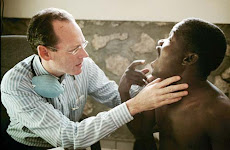Beak of Finch Discussion Solutions
1. Explain how Darwin viewed the finches of the Galapagos when he first found them? Why did he feel this way?
Darwin did not specify which island he found the finches. Collecting finches was part of his hobby and not what he considered research. In his mind he found several variations of one species and not several different species. He belief at this time was that species could not change.
2. On what basis did Peter Boag base his desire to conduct an egg switching experiment on Daphne Major? What did he hope to prove?
He was interested in Environment vs. Genetics. Would the new born hatchlings act more like their surrogate parents or their genetic parents? He wanted to prove that genes control behavior.
3. What happened on Daphne Major after the drought of 1977? How was natural selection being put to use?
Large birds and large beaks were favored as well as male birds due to the abundance of larger seeds that were harder to crack open.
4. Explain the experiment of Dolph Schluster and the stickle back fish? What is he trying to prove? Disprove?
Stickle back fish when found in the same lake can be found at the top of the lake and the bottom of the lake. When there is no competition the separate species can live anywhere in the lake. Schluter has created artificial ponds and lakes to find out if evolution occurs the same with and without competition. Will new traits appear in the presence and absence of competition?
5. Explain what happened on Daphe Major after the flood of 1983, and how natural selection was at work.
Small birds and small birds favored as well as female birds – the exact opposite as before the flood.
6. The Grants have discovered that hybrids are thriving on Daphne Major, explain why.
The Grants believe they are watching evolution at work. After the flood of 1983 the hybrids have been able to successfully breed. This they believe is possible due to the change in the environment caused by the floods.
7. The Grants have many concerns for the finches, but the El Nino is one of the issues at the top of the list. Why?
Drastic changes in weather can speed the rate of evolution. It may change the plant population of an area, change the predator population, or change the prey population. All of these factors may affect the success of certain traits and features in an organism. If the cactus disappears on the island many finch will also disappear.
1. Creation vs. Evolution
The themes of creation are present in the book as the dialogue between Darwin’s time and the Grant’s time is exchanged. Until the research of the Grants there was no hard evidence that evolution can happen. It was viewed as a theory. Darwin himself had a strong belief in creationism until his theory of evolution became more refined and through his studies and research he believed it was possible for organisms to have an ability to fashion new traits based on a change in the environment. The debate continues today between evolutionist and creationist as to the origins of life and the variety of species that exist today. Many scientists who are Christian believe that God created life that was capable of changing through a species DNA.
2. History vs. Present
Historical evidence provided using phrases and quotes from Origin of Species allow the reader to link ideas Darwin developed with ideas that scientist today are now testing and collecting raw data for. Darwin had many ideas and theories that went unexamined through research. However, many of his theories have shown to be correct through the work of the Grants, Boag, and Shulster. The work of Charles Darwin continues to influence modern day evolutionary biologist and researchers in the field of genetics and chemistry
3. Natural vs. Laboratory Environment
The natural environment such as the Galapagos islands is a perfect arena for collecting data because it is pristine and untouched by man and much of the pollution that society contributes to the ecosystem. However, islands and alpine lakes are not always practical and available for research.
Important scientific research is also done in a laboratory environment such as the artificial ponds that are being made by Shulster. Here variables can be controlled and data can be collected on a regular basis.
The question is are the results the same in a natural and laboratory environment – what are the advantages and disadvantages of each setting?
Subscribe to:
Post Comments (Atom)




No comments:
Post a Comment